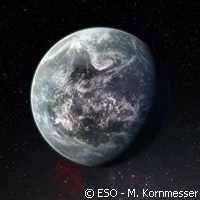ESO scientists discover 50 exoplanets with HARPS
European astronomers have discovered more than 50 new exoplanets orbiting nearby stars. Of this batch, 16 are super-Earths, what experts call extrasolar planets, with a mass higher than Earth's but much lower than the mass of the Solar System's gaseous giants. The team used the High Accuracy Radial Velocity Planet Searcher (HARPS) spectrograph, located at the European Southern Observatory's (ESO) La Silla Observatory in Chile. Presented at the recent Extreme Solar Systems conference in Wyoming, United States, this is the largest number of planets to be announced at one time. 'The harvest of discoveries from HARPS has exceeded all expectations and includes an exceptionally rich population of super-Earths and Neptune-type planets hosted by stars very similar to our Sun,' explains Michel Mayor of the University of Geneva in Switzerland, who led the project. 'And even better - the new results show that the pace of discovery is accelerating.' Astronomers have used HARPS since 2003 to survey stars like the Sun. Over this period, they have discovered more than 150 new planets. It should be noted that because of the HARPS, researchers have discovered around 66 % of all known exoplanets with masses below that of Neptune. The researchers say these findings are 'the fruit' of the lengthy work performed by the HARPS, which measures the radial velocity of a star with extraordinary precision. And thanks to the HARPS observations, space scientists have been able to provide better estimates about the possibility of whether a star like the Sun is host to low-mass planets, as opposed to gaseous giants. Around 40 % of such stars have at least one planet less massive than Saturn; most exoplanets that have a mass like that of Neptune or less seem to be in systems with multiple planets, they add. Sophisticated technology has resulted in HARPS being used not only for its stability but also for its sensitivity in the search for rocky planets capable of sustaining life. The team probed 10 nearby stars similar to the Sun; these stars are recognised for their suitability for extremely precise radial velocity measurements. The astronomers found 5 new planets with masses less than 5 times that of Earth within a 48-month period. 'These planets will be among the best targets for future space telescopes to look for signs of life in the planet's atmosphere by looking for chemical signatures such as evidence of oxygen,' says Francesco Pepe from the Geneva Observatory in Switzerland. Ascertaining which new planet is small, the researchers found that HD 85512 b is around 3.6 times the mass of the Earth. It is located at the end of the habitable zone, which is a narrow zone around a star that could have water under the right conditions. 'This is the lowest-mass confirmed planet discovered by the radial velocity method that potentially lies in the habitable zone of its star, and the second low-mass planet discovered by HARPS inside the habitable zone,' says Lisa Kaltenegger of the Max Planck Institute for Astronomy in Heidelberg, Germany and the Harvard Smithsonian Center for Astrophysics in Boston, United States. Commenting on the discovery of HD 85512 b, Professor Mayor says: 'The detection of HD 85512 b is far from the limit of HARPS and demonstrates the possibility of discovering other super-Earths in the habitable zones around stars similar to the Sun.' He goes on to say: 'In the coming 10 to 20 years we should have the first list of potentially habitable planets in the Sun's neighbourhood. Making such a list is essential before future experiments can search for possible spectroscopic signatures of life in the exoplanet atmospheres.' Professor Mayor discovered the first-ever exoplanet around a normal star in 1995.For more information, please visit: ESO:http://www.eso.org/public/HARPS:http://www.eso.org/sci/facilities/lasilla/instruments/harps/
Countries
Switzerland, Germany, United States



